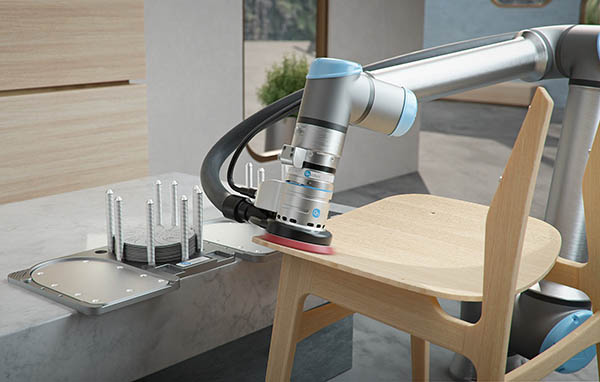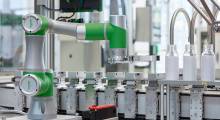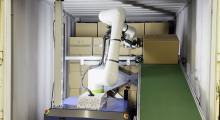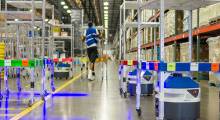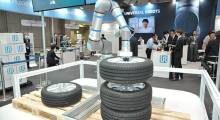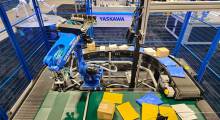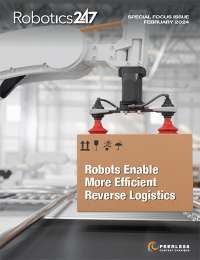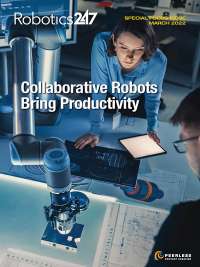Collaborative robots, or cobots, fundamentally change the nature of production by creating new synergies between humans and machines. By playing to the strengths of people and automation, multiple industries can improve productivity and product quality while reducing operating costs.
Equipped with sensors for safe collaboration and accurate manipulation, ways of learning new tasks without programming expertise, and a variety of end-of-arm tooling, cobots can bring flexibility to shops of all sizes.
Cobots promise to boost productivity
Collaborative robots can perform the dull, dirty, and dangerous tasks once performed by humans.
“This provides a double benefit,” said Joe Campbell, senior manager of applications development at cobot leader Universal Robots A/S. “Cobots take care of tasks humans are unavailable or unable to perform efficiently and safely, providing a powerful tool for companies struggling in the face of the ongoing manufacturing and warehousing labor crisis.”
“They also free humans to work on higher-order tasks, ensuring that companies get the best from both their human and automation resources,” he said. “This improves ergonomics and morale for human workers, reducing workplace strain and injury.”
In addition, this automation technology can achieve higher levels of repeatability and accuracy than humans performing the same tasks. In some cases, this precision can be measured at micron levels. This level of precision also translates to a reduction of raw material waste.
“Cobots are more consistent than human workers at performing certain tasks, are flexible enough to be deployed in a wide range of applications, and are easily transported and deployed,” said Campbell. “These qualities provide cobot users with additional productivity boosts.”
Furthermore, cobots can operate 24/7, shortening cycle times and supporting just-in-time manufacturing.
Automation helps users adapt to market demands
Another way cobots can help increase productivity is by providing companies with the agility required to quickly adapt to changing market demands.
For example, today’s manufacturers must be able to meet the growing demand for customization and shorter, more varied production runs. At the same time, warehouse and logistics companies must cultivate infrastructures flexible enough to handle the explosive growth of online purchases and the accompanying supply chain demands.
Fortunately, cobots have the functionality and flexibility required to meet these market demands.
“Collaborative automation is ideally suited to high-mix, low-volume production runs due to its combination of usability and flexibility,” said Kristian Hulgard, general manager for the Americas at end-effector provider OnRobot A/S. “Making adjustments to an application, such as adjusting the settings on a gripper or camera, is straightforward, even for those with no automation experience.”
“With the right end-of-arm tooling and software, a cobot can be deployed on any number of applications, from sanding to assembly to material handling and inspection,” he said. “This allows companies to respond quickly to changing requirements. Furthermore, user-friendly software interfaces have replaced the overly complex interfaces associated with traditional automation.”
Collaborative robots start in manufacturing
Tomenson Machine Works Inc. is an example of a manufacturer working with collaborative robots. The Chicago-based company looked for a machine-tending system to tend its pin stamper, a very repetitive process in the production of precision hydraulic manifolds.
One of the chief challengeswas that the pin stamper had to be able to handle hundreds of different part sizes. Therefore, Tomenson needed a cobot with an adaptive gripper capable of handling a wide range of units.
The system’s collaborative capability was also a critical element in the selection process because the unit had to be able to safely function in a tight working environment.
In the end, Tomenson selected Universal Robot’s UR5 arm equipped with OnRobot’s RG6 gripper.
According to Tomenson, the greatest benefit of using the system was a 40% reduction in misloads, a failing resulting from engraving in the wrong direction or on the wrong side of the part.
Profit margins also improved as Tomenson took on more high-volume, small-part jobs because it had confidence in the cobot’s ability to perform the task consistently and more accurately than a human. The automation also reduced engineering hours and allowed the company to reallocate workers to focus on bigger parts, with complex processes and longer cycles that require more attention.
Cobots find use in fulfillment and logistics
Another application demonstrating cobot capabilities can be seen at DCL Logistics, a full-service, third-party provider of fulfillment and logistics services. The Fremont, Calif.-based company has several years of hands-on experience with cobots that bear out the promise of increased productivity and efficiency.
“Our cobots are robotic arms that pick products from a storage shelf and place the products into a box,” said Brian Tu, chief revenue officer at DCL Logistics. “This is the interim step between when an order is placed in our system and when the box of products is packaged to ship to the customer.”
In addition, the modular nature of the system allowed the company to integrate the cobot into the existing workflow, obviating the need for large-scale system changes. Since it first deployed cobots, DCL has seen major improvements in its operations.
“Cobots have allowed us to increase the number of orders we process more accurately and more quickly,” Tu said. “Since our fall 2019 launch, we have seen a 200% increase in throughput on our fulfillment lines, a 60% decrease in direct labor, and 100% order accuracy. We have also developed the ability to run 24/7.”
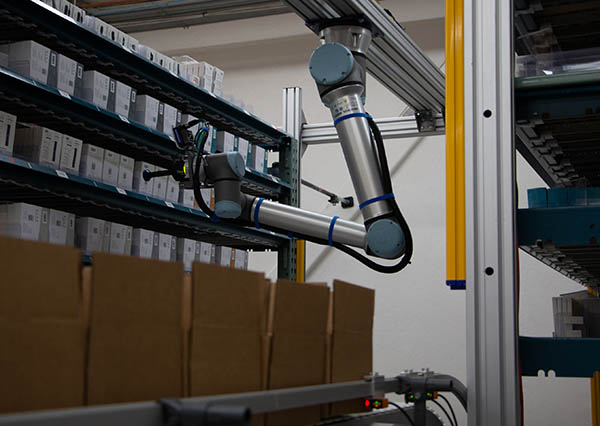
Cobots are not without challenges
Industry experts agree that the key to broader robot adoption lies in making the systems as easy and safe to deploy and use as possible. In practice, this means users should be able to program and install their cobots straight out of the box, without specialized training.
Even though cobot developers are investing much time and effort in this area, there is still room for improvement.
“Cobots were a good fit because they provided us with a modular solution to integrate into our system and workflow,” said Tu. “This, however, put the onus on us to program, install, and connect the cobots ourselves. This was a relatively slow process because there was a steep learning curve.”
“It took approximately 12 months of R&D to get the cobot production-ready,” he added. “We also had to train our staff to work alongside the cobots, run them, and troubleshoot and optimize them. This remains true as we deploy more cobots in more of our facilities.”
In addition to these deployment challenges, end users should be aware of the inherent limitations of cobot technology.
“By the nature of their design, cobots often operate slower than full industrial robots, so throughput should always be considered when placing a cobot into service,” said Dean Elkins, segment leader for handling at Yaskawa Motoman. “Additionally, limited payload designs will always see cobots placed in tasks that call for less lift capacity.”
Such limitations are valid concerns, but cobots still offer value and ease of use. “It’s important to note that the challenges involved in deploying cobots are orders of magnitude smaller than the challenges involved with traditional industrial automation,” said Campbell.
About the Author
Follow Robotics 24/7 on Linkedin
Article topics
Email Sign Up

